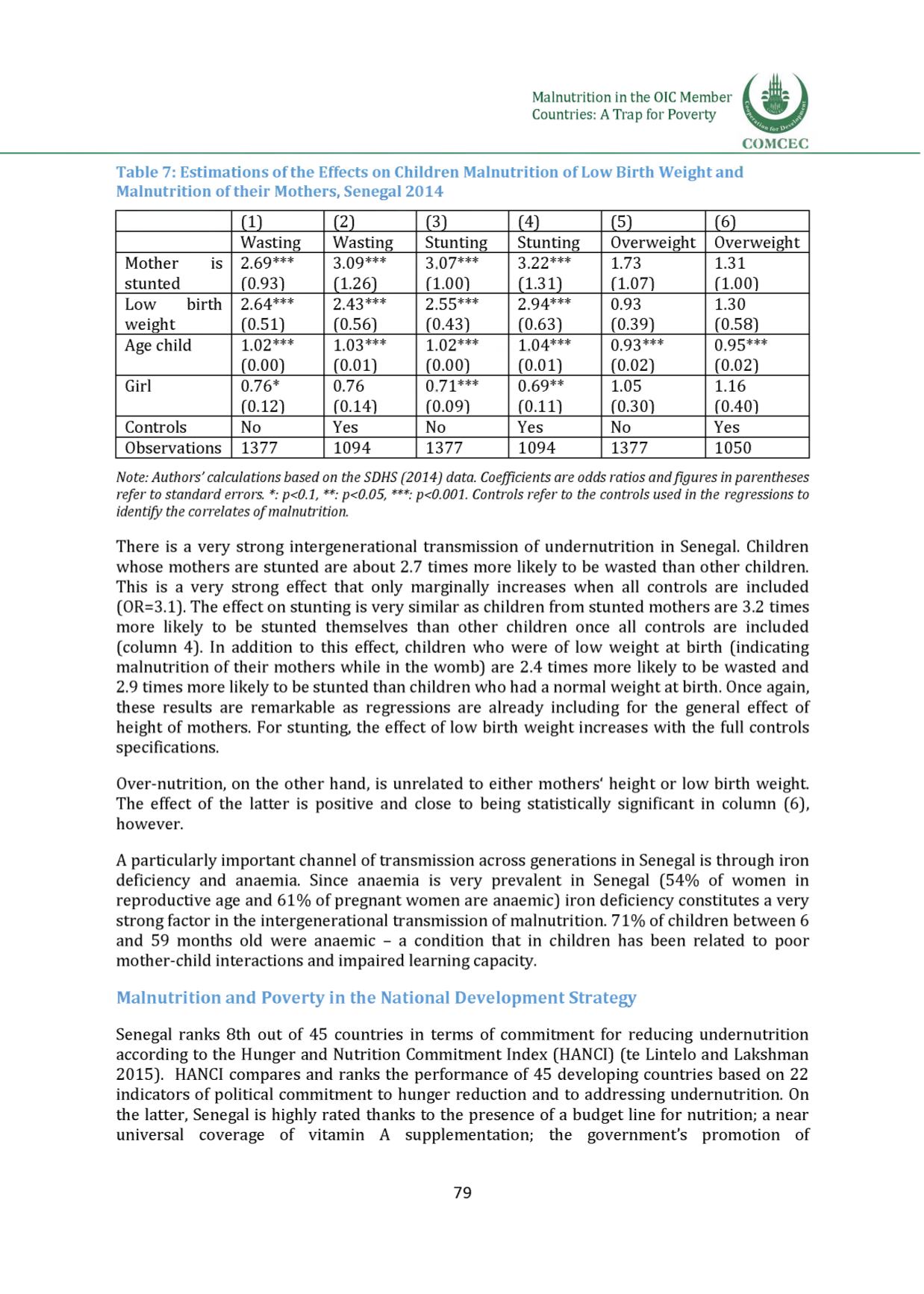

Malnutrition in the OIC Member
Countries: A Trap for Poverty
COMCEC
Table 7: Estimations of the Effects on Children Malnutrition of LowBirth Weight and
Malnutrition of their Mothers, Senegal 2014
(
1
)
(
2
)
(3)
(4)
(5)
(
6
)
Wasting Wasting Stunting Stunting Overweight Overweight
Mother
is
stunted
2.69***
(0.93)
3.09***
(1.26)
3 07***
(
1
.
0 0
)
3.22***
(1.31)
1.73
(1.07)
1.31
(
1
.
0 0
)
Low
birth
weight
2.64***
(0.51)
2.43***
(0.56)
2.55***
(0.43)
2
.
9 4
***
(0.63)
0.93
(0.39)
1.30
(0.58)
Age child
1
.
0 2
***
(
0
.
0 0
)
1.03***
(
0
.
0 1
)
1
.
0 2
***
(
0
.
0 0
)
1 04***
(
0
.
0 1
)
0.93***
(
0
.
0 2
)
0.95***
(
0
.
0 2
)
Girl
0.76*
(
0
.
1 2
)
0.76
(0.14)
0
71***
(0.09)
0.69**
(
0
.
1 1
)
1.05
(0.30)
1.16
(0.40)
Controls
No
Yes
No
Yes
No
Yes
Observations 1377
1094
1377
1094
1377
1050
Note: Authors' calculations based on the SDHS (2014) data. Coefficients are odds ratios andfigures in parentheses
refer to standard errors. *: p<0.1, **: p<0.05, ***: p<0.001. Controls refer to the controls used in the regressions to
identify the correlates ofmalnutrition.
There is a very strong intergenerational transmission of undernutrition in Senegal. Children
whose mothers are stunted are about 2.7 times more likely to be wasted than other children.
This is a very strong effect that only marginally increases when all controls are included
(OR=3.1). The effect on stunting is very similar as children from stunted mothers are 3.2 times
more likely to be stunted themselves than other children once all controls are included
(column 4). In addition to this effect, children who were of low weight at birth (indicating
malnutrition of their mothers while in the womb) are 2.4 times more likely to be wasted and
2.9 times more likely to be stunted than children who had a normal weight at birth. Once again,
these results are remarkable as regressions are already including for the general effect of
height of mothers. For stunting, the effect of low birth weight increases with the full controls
specifications.
Over-nutrition, on the other hand, is unrelated to either mothers' height or low birth weight.
The effect of the latter is positive and close to being statistically significant in column (
6
),
however.
Aparticularly important channel of transmission across generations in Senegal is through iron
deficiency and anaemia. Since anaemia is very prevalent in Senegal (54% of women in
reproductive age and 61% of pregnant women are anaemic) iron deficiency constitutes a very
strong factor in the intergenerational transmission of malnutrition. 71% of children between
6
and 59 months old were anaemic - a condition that in children has been related to poor
mother-child interactions and impaired learning capacity.
Malnutrition and Poverty in the National Development Strategy
Senegal ranks
8
th out of 45 countries in terms of commitment for reducing undernutrition
according to the Hunger and Nutrition Commitment Index (HANCI) (te Lintelo and Lakshman
2015). HANCI compares and ranks the performance of 45 developing countries based on 22
indicators of political commitment to hunger reduction and to addressing undernutrition. On
the latter, Senegal is highly rated thanks to the presence of a budget line for nutrition; a near
universal coverage of vitamin A supplementation; the government's promotion of
79
















